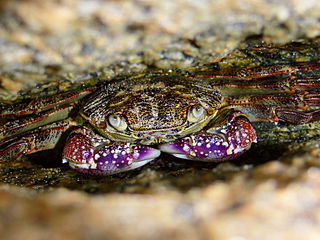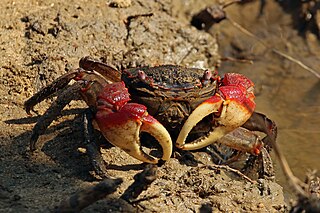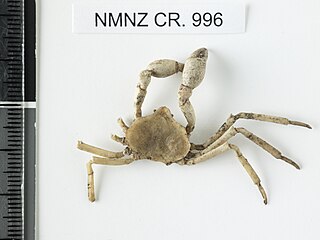
Henri Milne-Edwards was a French zoologist.

Leptograpsus variegatus, known as the purple rock crab, is a marine large-eyed crab of the family Grapsidae, found in southern subtropical Indo-Pacific Oceans. It grows to around 50 millimetres (2.0 in) shell width. It is the only species in the genus Leptograpsus.

Petrolisthes is a genus of marine porcelain crabs, containing these extant species:

Discoplax is a genus of terrestrial crabs. It is very closely related to the genus Cardisoma.

Ozius is a genus of crabs in the family Menippidae, containing the following species:

The Sesarmidae are a family of crabs, previously included in the Grapsidae by many authors. Several species, namely in Geosesarma, Metopaulias, and Sesarma, are true terrestrial crabs. They do not need to return to the sea even for breeding.

The Varunidae are a family of thoracotrematan crabs. The delimitation of this family, part of the taxonomically confusing Grapsoidea, is undergoing revision. For a long time, they were placed at the rank of subfamily in the Grapsidae, but they appear to be closest to Macropthalmus and the Mictyridae, which are usually placed in the Ocypodoidea. It may thus be better to merge the latter superfamily with the Grapsoidea, retaining the latter name as it is older.

Percnon gibbesi is a species of crab. It is one of at least two species commonly called Sally Lightfoot, and is also referred to as the nimble spray crab or urchin crab. It has been described as "the most invasive decapod species to enter the Mediterranean".

Heloecius cordiformis is a species of semiterrestrial crab found in mangrove swamps and mudflats along the east coast of Australia. Adults are around 25 mm (1 in) wide, with males being larger and having larger and more conspicuously coloured claws. The males wave their claws to communicate with other crabs, giving them their common name of semaphore crab. They can breathe both in air and under water, and feed at low tide on detritus in the sediment. H. cordiformis is the only species in the genus Heloecius and the family Heloeciidae.

Hemigrapsus is a genus of varunid crabs comprising thirteen species native almost exclusively in the Pacific Ocean, but two have been introduced to the North Atlantic region.

Geograpsus is a genus of crabs in the family Grapsidae, containing four extant species, and one extinct species:

Cyclograpsus is a genus of crabs, containing the following species:

Elamena is a genus of crab, containing the following species:

Austruca is a genus of indo-west Pacific fiddler crabs in the family Ocypodidae. There are about 13 described species in this genus.

Metasesarma is a genus of crabs in the family Sesarmidae.

Pseudohelice subquadrata is a species of crab in the family Varunidae. It is found from the eastern Indian Ocean to the western Pacific Ocean, north to Japan, south to Eastern Australia, east to French Polynesia, west to Indonesia and Thailand. It lives near mangroves, burrowing in firm soils, firm muddy sand or loose stones. Burrows are towards or above the high tide line on shores of estuaries and near river mouths of bays, and can have offshoots horizontal beneath the surface as long as three metres.

Paragrapsus laevis is a species of crab found in south eastern Australia, from southern Queensland to around the South Australian border, including Tasmania.

Aratus is a neotropical genus of tree-climbing mangrove crabs in the serarmid family. The genus was first described by Henri Milne-Edwards in 1853, by separating A. pisonii into its own monotypic genus. Aratus has a range spanning Baja California and Sonora, south to Peru along the east Pacific, and from Florida to Brazil in the west Atlantic. Though there has long been attempts to distinguish the Atlantic and Pacific populations of Aratus into separate taxa, it was not until 2014 that sufficient genetic and morphological evidence was collected for the Pacific population to be described as a distinct species.

Sesarmops is a genus of crabs in the family Sesarmidae. Its members are distributed through the Indo-West-Pacific oceanic region. They live in freshwater forest streams near the coast, and in mangroves.



















